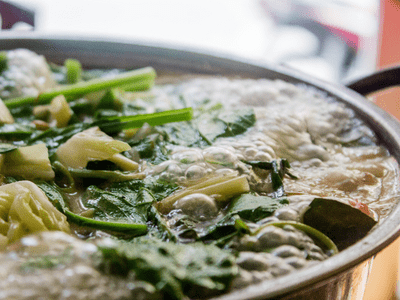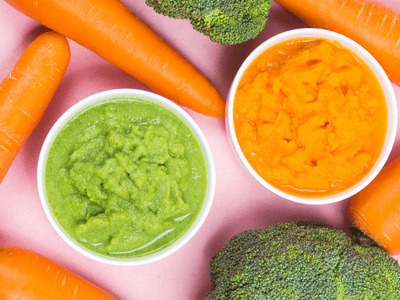Can you substitute cornstarch for baking powder? One of my favorite aspects of baking is the ability to substitute ingredients in recipes. I can’t tell you how many times I’ve started baking something only to realize I’m missing a key ingredient!
Cornstarch is one of the most common ingredients that I run out of first, whether I’m baking or cooking. Baking powder was the first powdery substance that came to mind, so I decided to start my experiment.
Baking powder cannot be used in place of cornstarch. Baking powder lacks the chemical components needed to replace cornstarch in recipes because it acts as a thickening agent. The addition of baking powder creates air bubbles but does not thicken the mixture.
When I discovered that baking powder was not a suitable substitute, I put my thinking cap on. I went on to find the best cornstarch substitutes that actually worked! When I’m baking and realize I’m out of cornstarch, I don’t panic because I have so many other options.
What Is the Difference Between Baking Powder and Cornstarch?
When I’m baking in my kitchen, I feel like a mad scientist working in my laboratory to create all of these different concoctions. I should start wearing a lab coat in the kitchen because there are so many ingredients that undergo chemical reactions to create beautiful and delicious desserts!
*You might also be interested in knowing more about the difference between cornstarch and baking powder. Read Is Cornstarch the Same as Baking Powder.
Ingredients interact with one another to produce a specific result. Cornstarch is one of the ingredients that can be used to thicken liquids.
To use, first prepare a slurry by combining equal parts cornstarch and water. Because it requires heat, this will not thicken your liquid yet. When you add your cornstarch slurry to your mixture and slowly heat it, it will thicken to the consistency you desire.
Baking powder, on the other hand, lacks the properties of cornstarch. As a result, it is a very poor thickening agent and should not be substituted.
Can You Substitute Cornstarch for Baking Powder?
Can you use baking powder instead of cornstarch? Baking powder cannot be used as a substitute because it contains a leavening agent. Baking powder is used in desserts to give them height by releasing carbon dioxide (like I said, very science-y). The formation of air bubbles caused by the release of carbon dioxide is what makes desserts light and airy.
I quickly realized that using baking powder as a substitute for cornstarch is a bad idea after experimenting with it. Adding baking powder will not make your mixture thicker. Instead, it will create air bubbles in your liquid rather than thickening it.
*Side Note: You may also be interested in learning how to properly store cake batter. I wrote an article about it, which you can read here! How to Store Cake Batter Properly,
Substitutes for Cornstarch in the Kitchen
Cornstarch is a pure starch powder extracted from corn kernels by removing the outer bran and germ, leaving only the starch-rich endosperm.
Examine This
Cornstarch has few health benefits unless you are underweight or a bodybuilder looking to bulk up. In such cases, cornstarch can significantly increase a person’s calorie intake.
Another advantage of cornstarch is that it is gluten-free. There are, however, risks. It can slow carbohydrate conversion and cause a spike in blood glucose levels if consumed in large amounts.
Consuming starches can also raise one’s risk of developing Type 2 diabetes. Cornstarch lacks the nutrients found in whole corn, such as protein, fiber, vitamins, and minerals, which slows the absorption of glucose.
Cornstarch is a common kitchen ingredient that is used for a variety of purposes. When heated, starch absorbs a lot of water, which is why cornstarch is used as a thickening agent in so many different sauces, fillings, and gravies.
We all know that thickening agents are an essential ingredient in making our favorite recipes more convenient, whether you’re making a delicious pie filling, frying for a crispy crust, or trying to perfect a gravy recipe.
If you don’t have cornstarch on hand, you might be wondering what a suitable cornstarch substitute is.
So you don’t have to panic the next time you run out of cornstarch, we’ve compiled a list of 9 suitable substitutes to try.
Check out our favorite cornstarch substitutes below to save yourself a trip to the store!
Wheat Flour

When in a pinch, wheat flour can easily be substituted for cornstarch. Wheat flour is the most commonly used flour in baking, so you’re more than likely to have this alternative on hand in your pantry or cupboard!
There are various types of wheat flour, and they are distinguished by the amount of gluten they contain.
When substituting wheat flour for cornstarch, keep in mind that while cornstarch will give the thickened recipe a glossy shine, flour will not have the same effect, resulting in a more matte final product.
You’ll need about 3 tablespoons of flour for every 1 tablespoon of cornstarch. It’s also worth noting that you’ll need to cook the recipe you’re thickening for a few minutes longer to ensure that the raw flavor of the flour isn’t present.
Heat Reduction

If you’re making a sauce, evaporation can be just as effective as adding something like flour or corn starch. However, patience is required! This method will take some time, and make sure to remove the pot’s lid to allow the steam to escape.
Vegetable Puree

Try thickening gravies, soups, casseroles, or stews with pureed vegetables to take your healthy eating to the next level. They are high in fiber, antioxidants, vitamins, and minerals.
Which ones you use will be heavily influenced by the type of dish you’re preparing. Cauliflower, pumpkin, potato, zucchini, and squash, on the other hand, can be boiled until soft. Then, either puree them in a blender or mash them with a potato masher.
Tapioca Flour
Tapioca flour is an excellent substitute for cornstarch. Tapioca is a starch extracted from the storage roots of cassava, a plant species native to northern and central-western Brazil but widely found throughout South America.
Tapioca flour is made by grinding cassava roots to a pulp and then filtering out the starch-rich liquid, which can then be dried to make tapioca flour!
Although cassava is an edible tuberous root, it frequently contains cyanogenic glycosides that can cause fatal cyanide poisoning. As a result, before it is safe to consume, the cassava plant must be properly detoxified by soaking, drying, and scraping.
Tapioca gives a beautiful, shiny finish to any dish, as opposed to regular flour, which is more matte. Tapioca flour can also save a lot of energy because it can gel with your dish at lower temperatures.
Unlike cornstarch, which tends to coagulate when refrigerated, this cornstarch substitute is an excellent choice for dishes that require chilling. It’s also worth noting that tapioca flour doesn’t benefit from long cooking times and can easily be overcooked if you’re not careful.
In conclusion
Can baking powder substitute cornstarch? Not really. But, there are numerous thickening agents available that work just as well as cornstarch in thickening stews, sauces, pie fillings, and other recipes. You don’t have to use just one ingredient to get the same or similar results.
If you find yourself in a situation where you don’t have enough cornstarch in your pantry the next time you go to cook a recipe, don’t be alarmed. As a cornstarch substitute, you can also use corn flour, cake flour, tapioca starch, baking powder, pastry flour, guar gum, arrowroot flour, potato flour, or baking soda.
Experiment with and enjoy some of our suggestions!